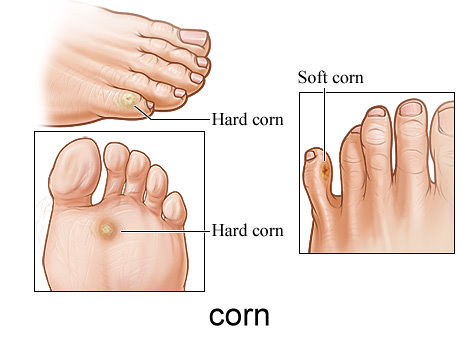
Signs and Symptoms for corn on foot:
You have a corn or callus if you notice:
You have a corn or callus if you notice:
- A thick, rough area of skin
- A hardened,raised bump
- Tenderness or pain under your skin
- Flaxy,dry or waxy skin.
Difference between corns and callus.
Corns are smaller than calluses and have a hard center surrounded by inflamed skin. They develop on parts of bodythat do not carry any weight, such as tops and sides of your toes. If corns are pushed then they can cause pain or suffer from a dull ache. Calluses usually develop on the soles of the feet, especially under the heels or balls, on the palms, or the knees. They are rarely painful and vary in size and shape. They can be more than inch in diameter, making them larger than corns.
Corns are smaller than calluses and have a hard center surrounded by inflamed skin. They develop on parts of bodythat do not carry any weight, such as tops and sides of your toes. If corns are pushed then they can cause pain or suffer from a dull ache. Calluses usually develop on the soles of the feet, especially under the heels or balls, on the palms, or the knees. They are rarely painful and vary in size and shape. They can be more than inch in diameter, making them larger than corns.
CALLUS

CORN

Causes of Corns and Calluses
- Ill-fitting shoes: When shoes are too tight, then your feet get compressed causing discomfort and corns and calluses develop. If the shoes are too loose, then the feet rub against the shoe. The foot may rub against a poorly placed seam or stitch inside the shoe.
- Skipping socks- Wearing shoes or sandals without socks can be a problem. Socks should fit properly.
- Using hand tools- The use of tools with your hands can also cause calluses on them.
Risk Factors that increase the incidence of calluses and corns on foot:
- Bunions or hammertoe- A bunion is an abnormal, bony bump that forms on the joint at the base of the big toe. A hammertoe is a toe deformity in which your toe becomes curled up like a claw. These conditions can cause rubbing of the feet in the shoes.
- Lack of protection for hands- Using hand tools without gloves can cause friction in the hands leading to corns and calluses.
- Foot Deformities- A pre-existing foot deformity, such as bone spur, may cause problems to your feet.
Treatment of Calluses and Foot Corns:
Severe or persistent corns need to be treated, although they rarely require surgery. Persons suffering from diabetes, or artherosclerosis should not treat a corn on their own, as it can increase the risk of infection. They are acid preparations to reduce corns and calluses. A commonly used preparation is a mixture of salicylic acid,lactic acids and collodion (Duofilm, Salactic Film and Viranol). Over the counter acids are weaker than the ones prescribed.
Severe or persistent corns need to be treated, although they rarely require surgery. Persons suffering from diabetes, or artherosclerosis should not treat a corn on their own, as it can increase the risk of infection. They are acid preparations to reduce corns and calluses. A commonly used preparation is a mixture of salicylic acid,lactic acids and collodion (Duofilm, Salactic Film and Viranol). Over the counter acids are weaker than the ones prescribed.
Acids should not be used by diabetic patients and are not advisable for individuals with impaired sensation or for the elderly with thin skin. Medicated pads are also available. Comfortable shoes should be worn.
Protect your feet from corn and calluses; but if you do suffer then take the necessary precautions to avoid any discomfort. One need not worry about them, if they are not painful.
No comments:
Post a Comment